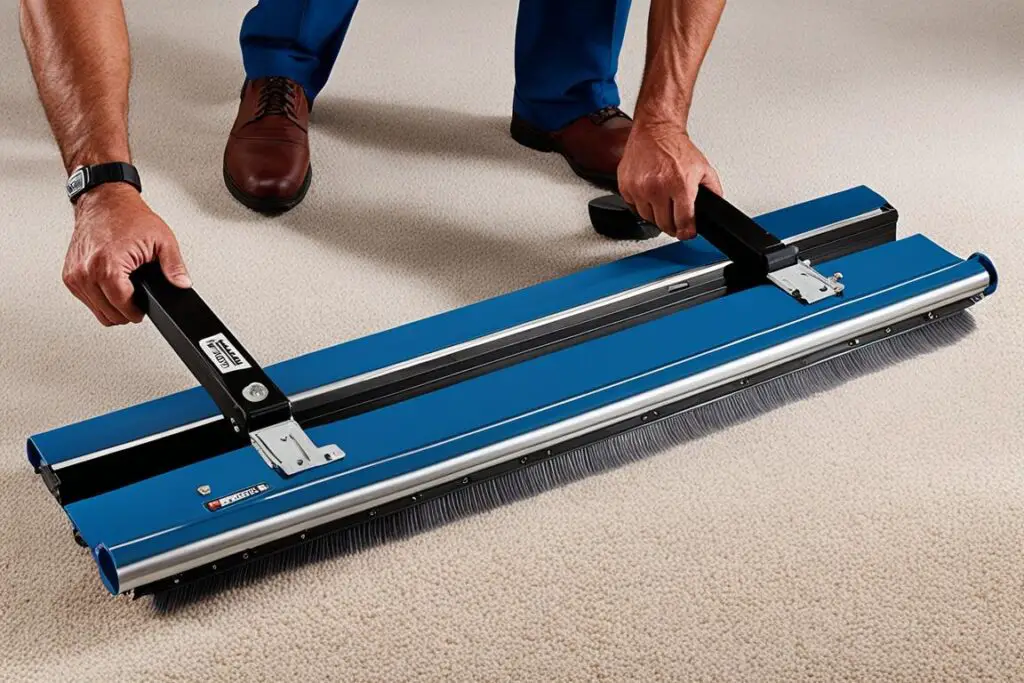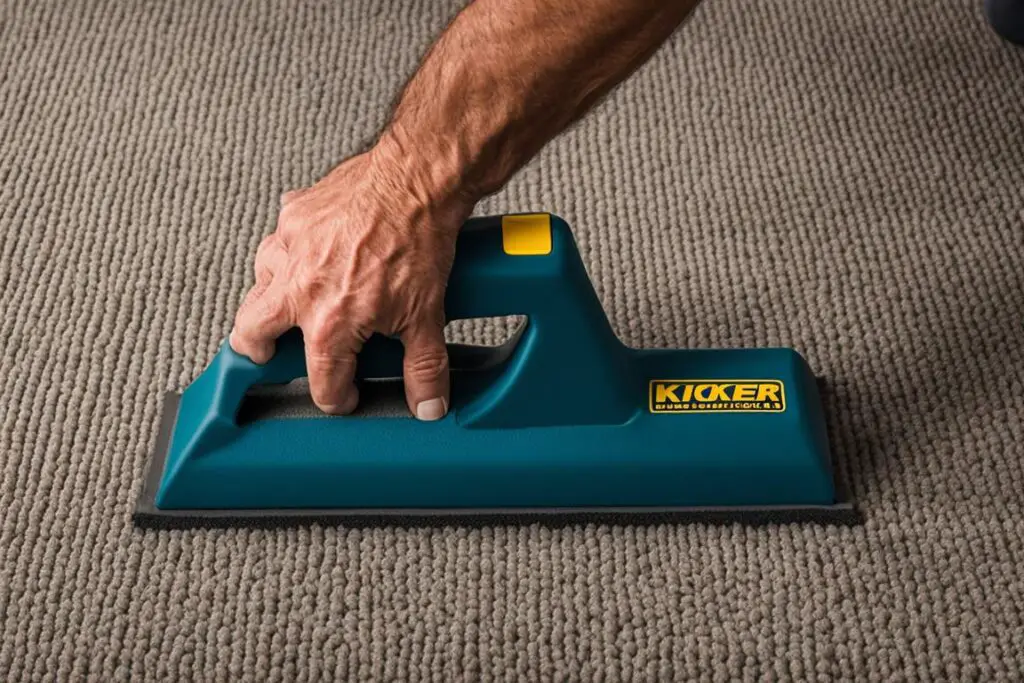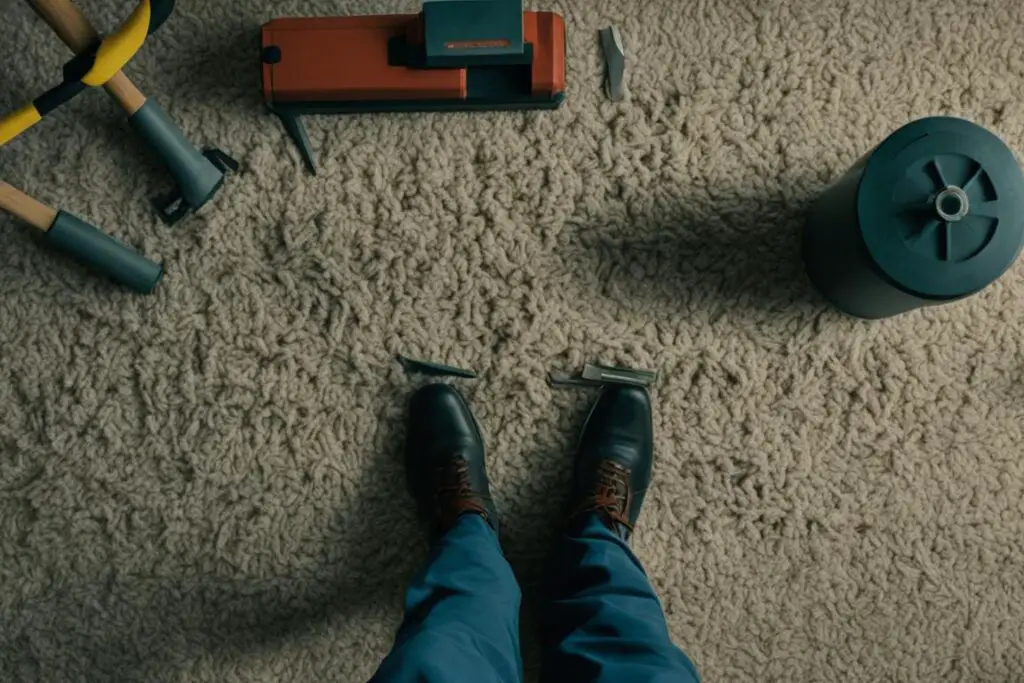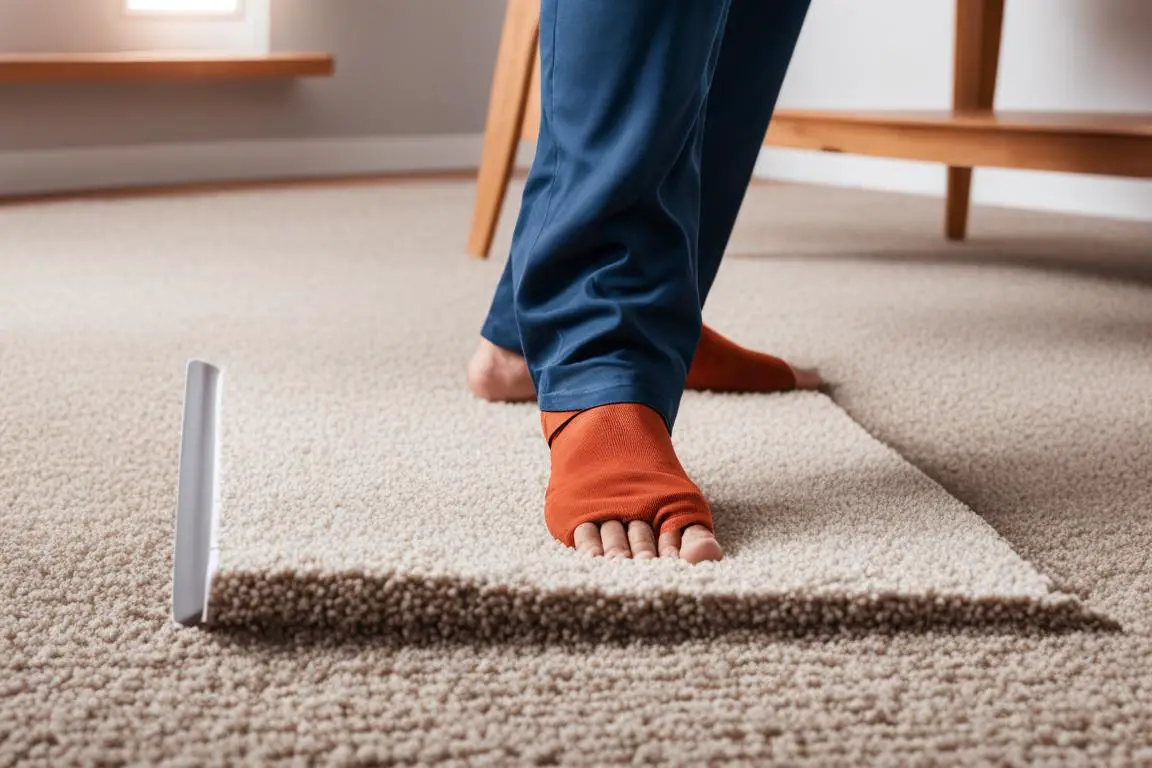If you have carpeted floors, you may have noticed some ripples or bumps. This is a common problem that can be addressed through carpet stretching and repair.
Carpet stretching involves removing any ripples or bumps in the carpet by properly stretching it and repositioning it. This process not only improves the appearance of the carpet but also makes it more comfortable to walk on.
In order to fix carpet bumps, it is important to understand why they occur in the first place. Most often, bumps are a result of the carpet not being installed properly. Over time, the backing of the carpet may deteriorate, the carpet pad may become compromised, or environmental factors like humidity may cause the carpet to ripple. By addressing these issues and properly stretching the carpet, you can restore its smooth and flawless appearance.
Key Takeaways:
- Carpet stretching and repair can help address ripples and bumps in your carpet.
- Improper carpet installation is often the cause of carpet bumps.
- Using the right tools and techniques is important for effective carpet stretching.
- Repairing damaged carpet is crucial to maintaining its appearance and longevity.
- There are some DIY methods for fixing carpet bumps, but professional tools and techniques may provide better results.
Now that you understand the importance of addressing carpet bumps and ripples, let’s explore the factors that contribute to proper carpet installation and the tools and techniques for carpet stretching.
The Importance of Proper Carpet Installation
Proper carpet installation is crucial in preventing bumps and ripples in the carpet. When carpet is installed professionally, it is laid down on top of a carpet cushion or pad, which is placed on the subfloor. Along the perimeter of the room, carpet tack strip is installed to hold the carpet in place. According to industry standards, the tack strip should be installed slightly less than the thickness of the carpet away from the wall. Additionally, the carpet pad should be of the correct thickness and density for the type of carpet being installed. When these guidelines are not followed during installation, the edges of the carpet can become loose, leading to an uneven surface and the formation of bumps and ripples.
To understand the importance of proper carpet installation, let’s take a closer look at the different factors involved:
- Carpet backing: The backing of the carpet provides stability and strength. It is important to choose a high-quality backing that resists wear and tear, ensuring that the carpet maintains its shape and appearance over time.
- Carpet pad: The carpet pad provides cushioning and insulation. It helps absorb impact, reduce noise, and enhance the overall comfort of the carpet. The right carpet pad should be selected based on the type of carpet and the level of foot traffic in the area.
- Carpet stretching: Properly stretching the carpet during installation ensures that it lies flat and does not have any wrinkles or bumps. This is essential for creating a smooth and even surface that is visually appealing and comfortable to walk on.
- Carpet ripples and bumps: When the carpet is not installed correctly, it can develop ripples and bumps over time. These imperfections not only detract from the aesthetic appeal of the carpet but can also pose a tripping hazard. By following proper installation techniques, these issues can be avoided.
By prioritizing proper carpet installation, you can prevent the formation of bumps and ripples in your carpet, ensuring a beautiful and durable flooring surface.
Tools and Techniques for Carpet Stretching
When it comes to carpet stretching, having the right tools and techniques is essential for achieving professional results. Whether you’re dealing with bumps, ripples, or wrinkles in your carpet, utilizing the correct equipment will ensure a smooth and flawless finish. Here are two of the main tools used for carpet stretching:
Power Stretcher
A power stretcher is an efficient and automated tool that harnesses the power of electricity and mechanical force to stretch the carpet along its edges and corners. This tool saves time and effort, making it ideal for larger areas or thicker carpets. With a power stretcher, you can achieve a consistent and even stretch, eliminating any unsightly bumps or ripples in your carpet.
Carpet Knee Kicker
On the other hand, a carpet knee kicker is a manual tool that relies on the user’s leg muscles and leverage to stretch specific areas of the carpet. This kick-and-stretch motion allows for more precision and control, making it suitable for smaller areas or tight corners that may be challenging to reach with a power stretcher. The carpet knee kicker is a versatile tool that complements the power stretcher, ensuring every part of the carpet is properly stretched and aligned.
By using a combination of a power stretcher and a carpet knee kicker, you can tackle any carpet stretching project with confidence. These tools, when used together, provide a comprehensive solution for addressing bumps, ripples, and wrinkles in your carpet. Now let’s take a look at the power stretcher and carpet knee kicker in action:
| Power Stretcher | Carpet Knee Kicker |
|---|---|

|

|
| The power stretcher uses electricity and mechanical force to stretch the carpet. | The carpet knee kicker relies on the user’s leg muscles and leverage for precision stretching. |
| Recommended for larger areas or thicker carpets. | Perfect for smaller areas or tight corners. |
| Ensures a consistent and even stretch. | Provides precision and control in hard-to-reach areas. |
With the right tools and techniques, carpet stretching becomes a breeze. Whether you’re tackling a DIY project or seeking professional help, a power stretcher and a carpet knee kicker are invaluable assets for achieving a smooth and flawless carpet finish. So, let’s equip ourselves with these tools and say goodbye to unsightly carpet bumps and ripples!
Repairing Damaged Carpet
In addition to stretching the carpet to remove bumps and ripples, it may also be necessary to repair damaged sections of the carpet. Carpet repairs involve replacing parts of the carpet that are too badly damaged with new pieces of material. This helps ensure that the carpet looks uniform without any noticeable patches or tears. By addressing damaged areas promptly, you can prevent further deterioration and extend the lifespan of your carpet. It is important to have these repairs done by experienced professionals who understand how different types of fabrics react to different conditions.
DIY Methods for Fixing Carpet Bumps
If you prefer to tackle carpet repairs yourself, there are a few DIY methods you can try to fix bumps and wrinkles in the carpet. One method is reverse rolling the rug by gently turning it face down and rolling it in the opposite direction. Leave the rug rolled up for a day or two to allow the fibers to relax and return to their natural shape.
Another method is using weights such as books or plants to place on the curled or bumpy parts of the rug. The weight helps the fibers relax and flatten out.
You can also try exposing the rug to sunlight for a few hours to soften the fibers and remove wrinkles. Alternatively, you can use a steam cleaner to achieve similar results.
However, it is important to note that these DIY methods may not always provide the same professional results as using specialized tools and techniques.
For a visual representation of some DIY methods for fixing carpet bumps, check out the image below:

Remember, if your carpet has extensive damage or if you’re not confident in your DIY skills, it’s always best to consult a professional to ensure a proper repair.
Preventing Future Carpet Bumps
Once you have successfully removed bumps and ripples from your carpet, it is important to take preventative measures to avoid future issues. By following these simple steps, you can maintain your carpet’s smooth and flawless appearance for a longer period of time.
Use a High-Quality Rug Pad
A rug pad is an essential accessory for preventing carpet bumps. It provides stability and cushioning, keeping your carpet in place and minimizing the chances of it stretching or folding. Invest in a high-quality rug pad that is suitable for your carpet type and size. A good rug pad will also add an extra layer of comfort underfoot.
Secure Edges with Double-Sided Carpet Tape
Double-sided carpet tape can be a valuable tool in preventing bumps along the edges of your carpet. Especially in areas prone to shifting or movement, such as hallways or high-traffic zones, apply double-sided carpet tape to secure the edges of the carpet to the floor. This will help keep the carpet taut and prevent any ripples or bumps from forming.
Avoid Furniture Dents
Heavy furniture can leave unsightly dents on your carpet over time. To prevent this, place furniture coasters or pads underneath the legs of your furniture. These protective pads distribute the weight more evenly and minimize the pressure on the carpet fibers. If you already have furniture dents on your carpet, try this simple trick: place ice cubes on the dents and let them melt overnight. The moisture from the ice cubes will help the carpet fibers absorb the moisture and regain their original form.
By implementing these preventative measures and regularly maintaining your carpet, you can enjoy a smooth and bump-free carpet for years to come.
Conclusion
Fixing bumps in the carpet is a common issue that can be easily resolved through carpet stretching and repair. By understanding the importance of proper carpet installation, using the right tools and techniques, and implementing preventative measures, you can restore your carpet to a smooth and flawless state.
Proper carpet installation plays a crucial role in preventing bumps and ripples. Following industry standards for carpet padding, tack strip placement, and carpet thickness ensures a secure and even surface. However, if bumps do appear, utilizing specialized tools like a power stretcher and a carpet knee kicker can provide professional results.
Furthermore, addressing damaged areas promptly and executing proper carpet repairs are essential in maintaining a uniform and attractive look. Whether you prefer to hire professionals or embark on a DIY approach, it is important to act promptly to prevent further damage or deterioration.
Lastly, taking preventive measures contributes to the long-term smoothness of your carpet. Using a high-quality rug pad under the carpet, securing edges with double-sided carpet tape, and addressing furniture dents promptly are effective ways to prevent future bumps. By incorporating these maintenance practices, your carpet will remain bump-free and flawless for years to come.
FAQ
How can I fix bumps in my carpet?
You can fix bumps in your carpet by stretching it properly. This involves using tools like a power stretcher or a carpet knee kicker to remove any ripples or bumps and reposition the carpet. By addressing the underlying causes, such as improper installation or environmental factors, you can restore your carpet’s smooth appearance.
What causes bumps in the carpet?
Bumps in the carpet are usually caused by improper installation, deteriorating carpet backing, compromised carpet pads, or environmental factors like humidity. When the carpet edges become loose or the padding is no longer effective, the carpet can develop ripples or bumps over time.
How should carpet be installed to prevent bumps?
Proper carpet installation is essential to prevent bumps. The carpet should be laid on top of a carpet cushion or pad, which is placed on the subfloor. Carpet tack strips should be installed along the perimeter of the room, slightly less than the thickness of the carpet away from the wall. The carpet pad should also be of the correct thickness and density. Following these guidelines during installation helps to secure the edges of the carpet and prevent the formation of bumps.
What tools are used for carpet stretching?
Carpet stretching requires the use of specific tools such as a power stretcher and a carpet knee kicker. A power stretcher uses electricity and mechanical force to stretch the carpet along its edges and corners. A carpet knee kicker, on the other hand, relies on the user’s leg muscles and leverage to stretch specific areas of the carpet. Using these tools together achieves a consistent and professional look.
Can I repair damaged sections of my carpet?
Yes, damaged sections of the carpet can be repaired. This involves replacing the damaged portion with new carpet material. By addressing damaged areas promptly, you can prevent further deterioration and maintain a uniform appearance without noticeable patches or tears.
Are there any DIY methods to fix carpet bumps?
Yes, there are some DIY methods you can try to fix carpet bumps. For example, you can try reverse rolling the carpet, using weights to flatten out the bumps, or exposing the carpet to sunlight or steam. However, it’s important to note that these methods may not always provide the same professional results as using specialized tools and techniques.
How can I prevent future carpet bumps?
To prevent future carpet bumps, you can use a high-quality rug pad under your carpet to keep it in place and prevent stretching or folding. You can also use double-sided carpet tape to secure the edges of the carpet to the floor, especially in areas prone to bumps. Additionally, placing ice cubes on furniture dents on the carpet can help the fibers absorb moisture and return to their original form.



